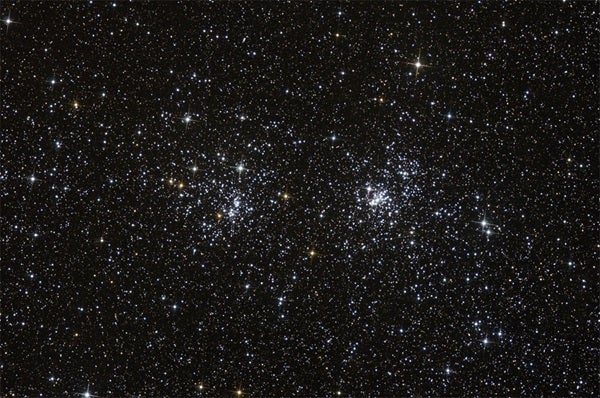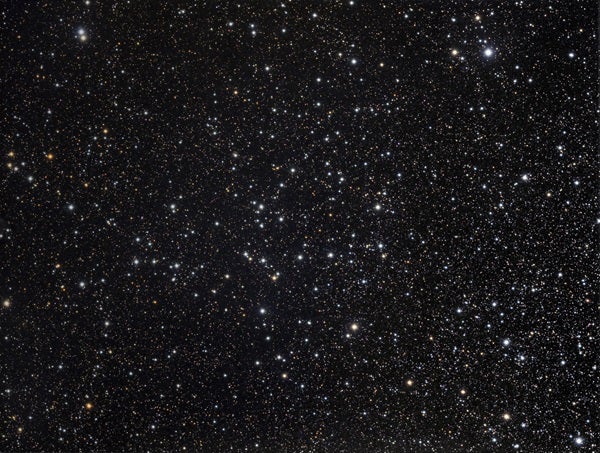If you have trouble spotting it, scan through your binoculars along a line extending from Gamma (γ) Cassiopeiae, the center star of the W, through Ruchbah (Delta [δ] Cassiopeiae) and continuing toward the southeast. Maintain a straight course, and you will see both clusters as two clumps of stars.
Few autumn clusters compare to either NGC 869 or NGC 884 alone. But when you add both together, the field literally overflows with stars. And unlike many star clusters, which need telescopes to be seen at their best, NGC 869 and 884 are just as wonderful through binoculars. In fact, in my opinion, while they are impressive through telescopes, the narrower views sacrifice the area’s overall beauty.
Last fall, I had a chance to view the clusters through monstrous 25×100 binoculars as the pair rose just above some distant pine trees. The field overflowed with stardust, pouring over and around the distant pines. The view was magnificent, creating a magical moment that could never be captured in a photo, but whose image is forever filed away in my mind’s astronomical album.
History doesn’t record who discovered the Double Cluster, but we do know that their combined presence attracted the eyes of Hipparchus back in the second century b.c., when he mentioned them in his notes. Three centuries later, Ptolemy recorded them in the Almagest as a nebulous or misty spot at the tip of Perseus’ right hand. Messier apparently knew of the Double Cluster, but never recorded them in his catalog. Why he ignored them but included the likes of M73 (a four-star asterism in Aquarius) is difficult to understand.
Are the two clusters actually physically linked to one another? They almost certainly have some gravitational effect each other, since NGC 869 (the westernmost cluster) is 7,100 light-years away, while NGC 884 is slightly farther at 7,400 light-years. Both are primarily composed of hot type A and type B supergiant, superluminous stars. Some 200 call NGC 869 home, while NGC 884 is made up of about 150. Several red supergiants are seen in NGC 884, but are conspicuously absent in NGC 869.
Stock 2’s 50 member stars cover a full degree of sky, the same as two Full Moons stacked end to end. About 20 of these stars can be resolved through 10x binoculars, although they only shine between 7th and 9th magnitude.
Take a long, careful look at the stars in Stock 2 and let your imagination run wild for a moment. See any pattern among them? Careful scrutiny will show that the stars seem to fall into four distinct threads curving away from the center.
My longtime friend John Davis from Amherst, Massachusetts, has mentioned to me that the brighter stars look like a headless stick figure flexing his muscles. He christened it the “Muscleman Cluster.” Can you spot him? His legs stretch out in two straight lines to the east, while his flexing arms curve to the west.
Imagine Stock 2 as a muscleman, figure skater, or ballerina as you wish. The next time you are enjoying the beauty of the Double Cluster, be sure to swing northward to enjoy this underappreciated beauty.
I’d love to hear about your binocular adventures and conquests. Contact me through my website, philharrington.net.
Until next month, remember that two eyes are better than one.












